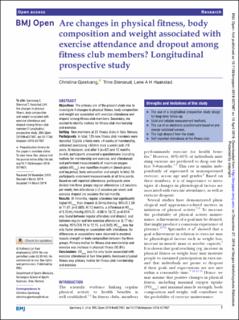| dc.contributor.author | Gjestvang, Christina | |
| dc.contributor.author | Stensrud, Trine | |
| dc.contributor.author | Haakstad, Lene Annette Hagen | |
| dc.date.accessioned | 2020-04-29T08:40:01Z | |
| dc.date.available | 2020-04-29T08:40:01Z | |
| dc.date.created | 2019-08-14T13:17:14Z | |
| dc.date.issued | 2019 | |
| dc.identifier.issn | 2044-6055 | |
| dc.identifier.uri | https://hdl.handle.net/11250/2652867 | |
| dc.description | This is an open access article distributed in accordance with the Creative Commons Attribution Non Commercial (CC BY-NC 4.0) license, which permits others to distribute, remix, adapt, build upon this work non-commercially, and license their derivative works on different terms, provided the original work is properly cited, appropriate credit is given, any changes made indicated, and the use is non-commercial. See: http://creativecommons.org/licenses/by-nc/4.0/. | en_US |
| dc.description.abstract | Objectives: The primary aim of the present study was to investigate if changes in physical fitness, body composition and weight are associated with exercise attendance and dropout among fitness club members. Secondary, we wanted to identify motives for fitness club membership and exercise.
Setting: New members at 25 fitness clubs in Oslo, Norway. Participants In total, 125 new fitness club members were recruited. Eligible criteria were <4 weeks of membership, untrained (exercising <60min once a week) and ≥18 years. At inclusion, and after 3 (n=87) and 12 months (n=64), participants answered a questionnaire (including motives for membership and exercise, and attendance) and performed measurements of maximum oxygen uptake (VO2max), one repetition maximum (bench press and leg press), body composition and weight. In total, 56 participants underwent measurements at all time points. Based on self-reported attendance, participants were divided into three groups: regular attendance (≥2 sessions per week), low attendance (<2 sessions per week) and exercise dropout (no sessions the last month).
Results: At 3months, regular attendees had significantly higher VO2max than dropout (6.54mL/min/kg, 95%CI 2.00 to 11.07, p=0.003). At 12 months, a difference in VO2max of 5.32mL/min/kg (95%CI −0.08 to 10.72, p=0.054) was found between regular attendees and dropout, and between regular and low exercise attendance (6.17mL/ min/kg, 95%CI 0.19 to 12.15, p=0.042). VO2max was the only factor showing an association with attendance. No differences or associations were observed in maximal muscle strength or body composition between the three groups. Primary motive for fitness club membership and exercise was increase in physical fitness (92.8%).
Conclusions: VO2max was the only factor associated with exercise attendance at two time points. Increased physical fitness was primary motive for fitness club membership and exercise. | en_US |
| dc.language.iso | eng | en_US |
| dc.subject | bioelectrical-impedance analysis | en_US |
| dc.subject | perceived exertion | en_US |
| dc.subject | resistance exercise | en_US |
| dc.subject | self-efficacy | en_US |
| dc.subject | oxygen-uptake | en_US |
| dc.subject | health | en_US |
| dc.subject | strength | en_US |
| dc.subject | adults | en_US |
| dc.subject | motivation | en_US |
| dc.subject | intensity | en_US |
| dc.title | Are changes in physical fitness, body composition and weight associated with exercise attendance and dropout among fitness club members? Longitudinal prospective study | en_US |
| dc.type | Peer reviewed | en_US |
| dc.type | Journal article | en_US |
| dc.description.version | publishedVersion | en_US |
| dc.rights.holder | © Author(s) (or their employer(s) 2019. | en_US |
| dc.source.volume | 9 | en_US |
| dc.source.journal | BMJ Open. 2019, 9(4), e027987. | en_US |
| dc.source.issue | 4 | en_US |
| dc.identifier.doi | 10.1136/bmjopen-2018-027987 | |
| dc.identifier.cristin | 1715893 | |
| dc.description.localcode | Seksjon for idrettsmedisinske fag / Department of Sports Medicine | en_US |
| cristin.unitcode | 150,34,0,0 | |
| cristin.unitname | Seksjon for idrettsmedisinske fag | |
| cristin.ispublished | true | |
| cristin.fulltext | original | |
| cristin.qualitycode | 1 | |
